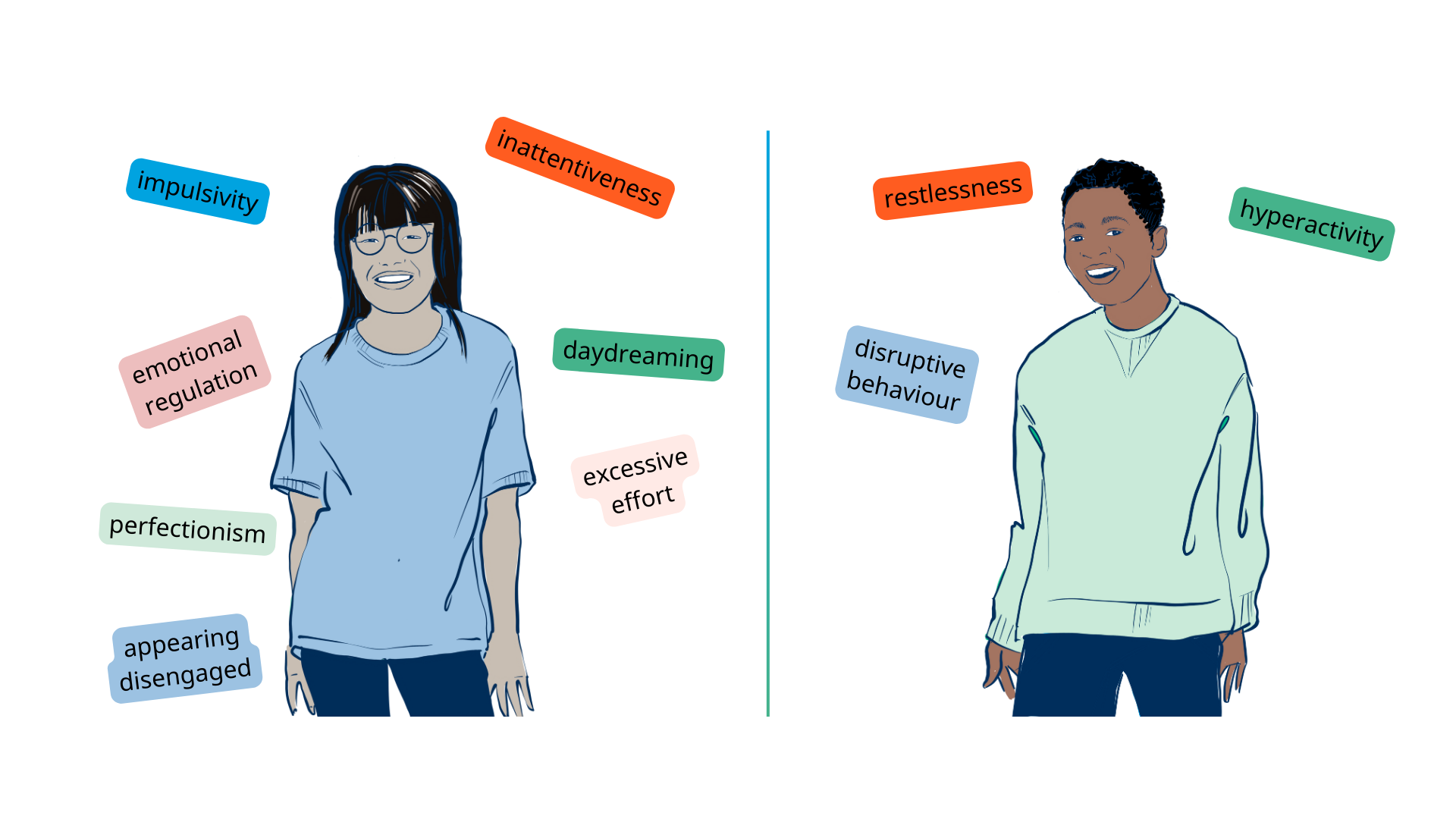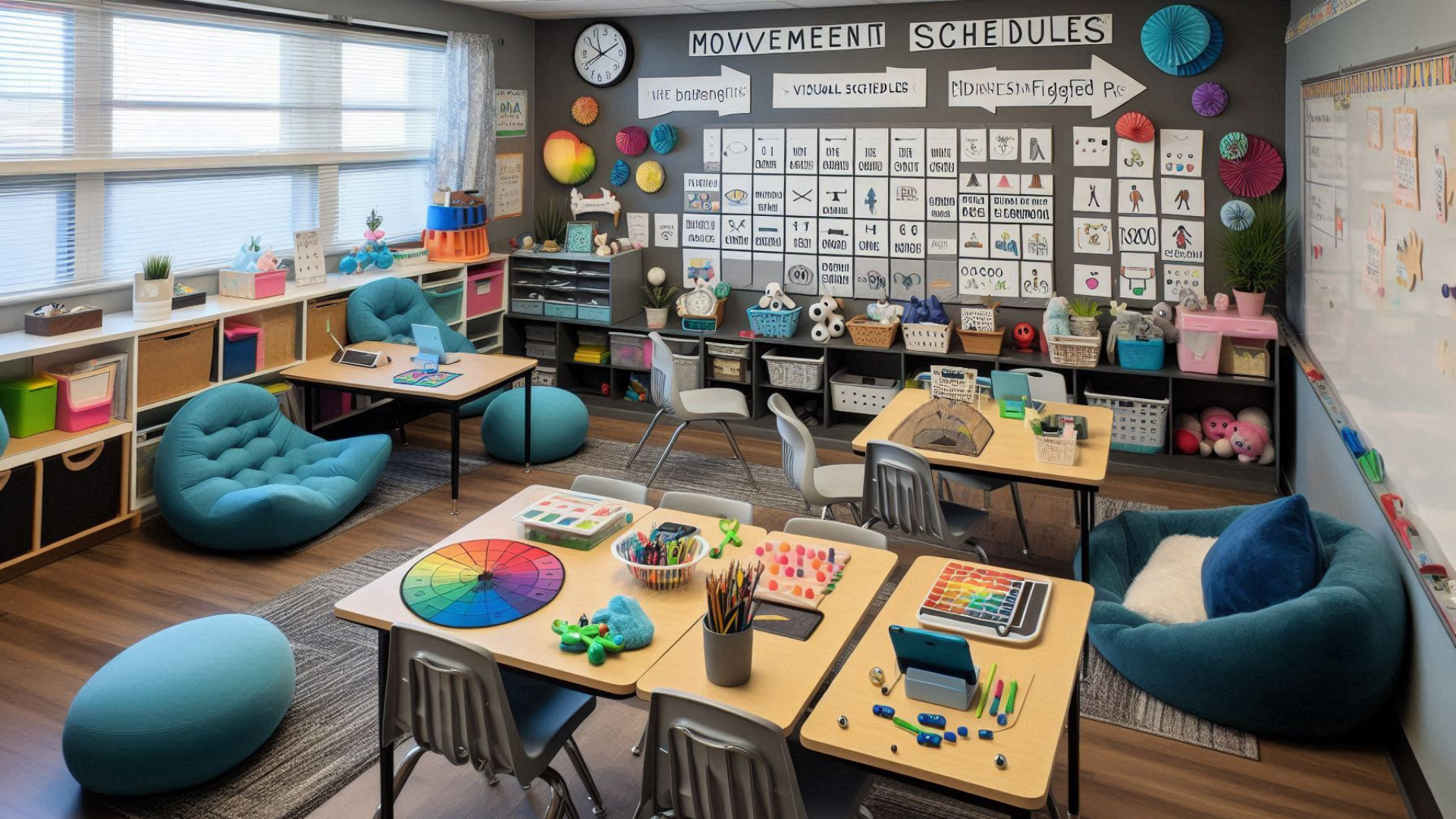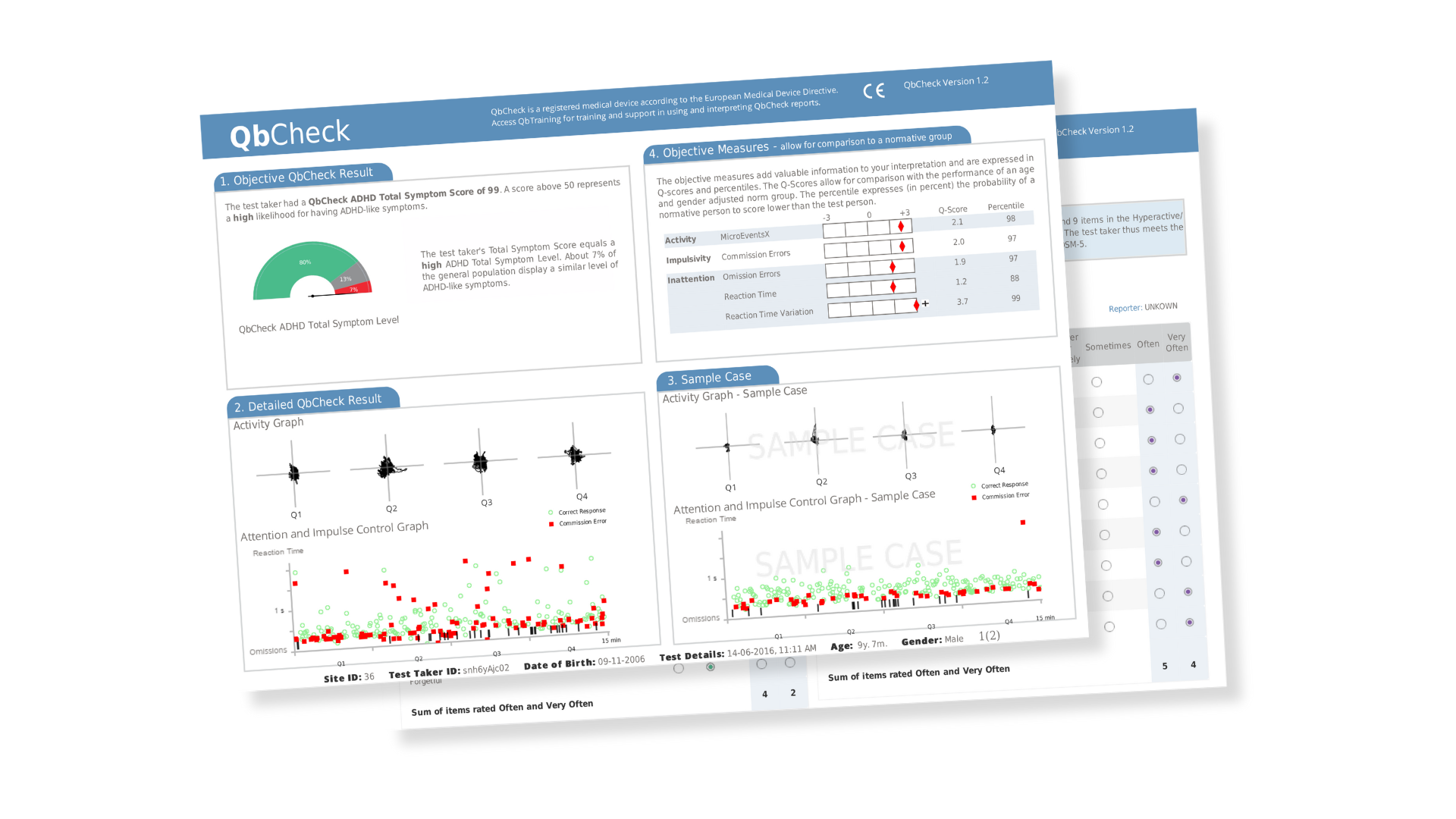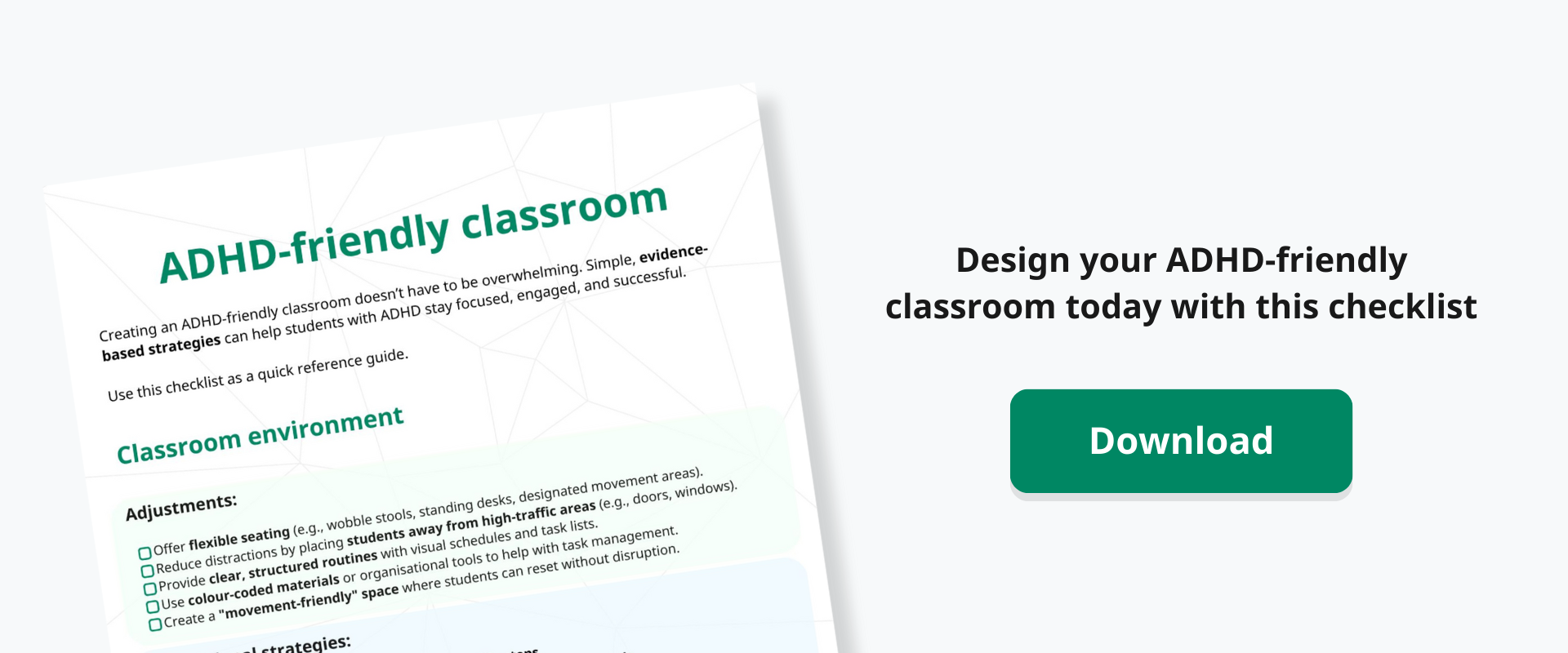Supporting students with ADHD is one of the most common yet complex challenges teachers face in today’s classrooms. With an estimated 11.4% of children in the US diagnosed with ADHD, educators are often on the front lines of identifying symptoms and implementing strategies to help these students succeed.
Recognizing ADHD and providing effective support can be daunting unless you have the right tools and knowledge.
This toolkit is designed to equip teachers with actionable strategies for managing ADHD in the classroom, from understanding the key signs to implementing practical interventions.
Whether you’re a new teacher looking to understand ADHD better or a seasoned educator searching for effective resources, this guide will provide the clarity and support you need.
Understanding ADHD
What is ADHD?
ADHD is a neurodevelopmental condition that affects a student’s ability to focus, regulate impulses, and manage energy levels appropriately.
There are three main types of ADHD:
- Inattentive type: Characterized by a difficulty sustaining attention, frequent daydreaming, and being easily distracted.
- Hyperactive-impulsive type: Involves constant movement, fidgeting, and impulsive actions or speech.
- Combined type: A mix of inattentive and hyperactive-impulsive traits.
It is important to note though, that ADHD often manifests differently across age groups and genders, making it essential for educators to understand the varied presentations. There are some myths out there that make it difficult to understand ADHD fully – let’s take a look at some…
Common myths DEBUNKED
Myth: ADHD is an excuse for bad behavior
Truth: Never. ADHD is a recognized neurodevelopmental condition (and so often misunderstood) that requires understanding and tailored support.
Myth: ADHD only occurs in boys.
Truth: Absolutely not. Girls often present with inattentive symptoms like forgetfulness, and difficulty paying attention (although more research is coming out that girls can be just as hyperactive as boys), and go undiagnosed until adulthood, while boys are often diagnosed and treated much earlier.
Myth: Children outgrow ADHD
Truth: No. ADHD persists into adulthood for many individuals, and while presentations of ADHD can change over time, adults still experience brain differences and can be majorly affected by the condition.
Myth: ADHD is about focus – it doesn’t impact emotions
Truth: Not true. Emotional dysregulation is one of the core challenges of ADHD. Students with ADHD will often experience intense emotions, struggle with frustration tolerance, and can have difficulty managing impulsive reactions. This can affect social interactions, classroom behavior, and self-esteem. Understanding this aspect of ADHD is crucial for teachers to provide the right support.
Understanding comorbidity in ADHD
It’s important to note that ADHD often doesn’t exist in isolation – many students with ADHD have coexisting conditions, known as comorbidities. These can include:
- Learning disabilities, such as dyslexia or dyscalculia, which can further impact academic performance.
- Anxiety or mood disorders, which can make it difficult for students to manage emotions effectively.
- Sensory processing difficulties, which may lead to heightened sensitivity to noise, textures, or lighting in the classroom.
Recognizing ADHD in the classroom
As educators, understanding how ADHD manifests in the classroom is vital for early identification. While ADHD symptoms can present differently based on factors such as age and gender, there are key behaviors teachers can look out for to identify potential cases. Recognizing these patterns early can help ensure students receive the support they need to thrive.
General signs of ADHD in the classroom

Understanding ADHD requires recognizing that the condition can present differently depending on the student. While some signs may be more universally observed, others are influenced by factors such as gender or individual coping mechanisms. Teachers must understand these nuances to avoid missing key indicators or misinterpreting behaviors.
Some general signs to watch out for might include:
- Difficulty sustaining attention: Students may frequently drift off during tasks or struggle to complete assignments, especially if they require sustained focus.
- Restlessness or physical activity: This can manifest as constant movement, such as fidgeting, tapping, or repeatedly leaving their seat.
- Impulsivity in speech and actions: Students may interrupt others, blurt out answers, or struggle to wait their turn during activities.
- Disorganization and forgetfulness: Commonly losing materials like books or pencils and forgetting assignments or deadlines.
- Emotional regulation challenges: Frustration over minor issues, frequent mood swings, or appearing overly sensitive to feedback.
Potential differences between male and female students with ADHD:
It is essential to note that ADHD often manifests differently in male and female students, and these differences can influence how teachers identify the condition:
Male students:
- More likely to exhibit externalized symptoms such as hyperactivity, restlessness, and disruptive behavior.
- Teachers may more readily identify these behaviors as ADHD due to their impact on the classroom environment.
Female students:
- More likely to show internalized symptoms such as inattentiveness, daydreaming, or appearing disengaged.
- Girls may mask their struggles by overcompensating with perfectionism or excessive effort, leading to delayed identification.
- Girls with ADHD may also struggle with social isolation if they find it difficult to sustain attention in conversations with peers. Others may experience ongoing relationship conflicts due to impulsivity, such as blurting out comments or struggling with emotional regulation in friendships.
By recognizing these distinctions, teachers can better understand how ADHD might appear in different students and ensure timely support is provided.
Examples of behaviors that indicate ADHD:
- A student who consistently forgets homework or loses essential items like books or pencils, despite repeated reminders.
- Difficulty transitioning between activities, often requiring repeated prompts to refocus.
- A student who appears disengaged but is actually overwhelmed by the inability to sustain focus or process instructions effectively.
By understanding these general patterns and the nuanced differences between male and female students, teachers can better document observations and collaborate with parents and specialists to provide timely and effective interventions.
Strategies for supporting students with ADHD
Effectively supporting students with ADHD requires a balance of structure and flexibility. By tailoring classroom strategies to meet their unique needs, teachers can create an environment where every student feels included and empowered.
Classroom tips
Small but deliberate changes in the classroom setup can make a significant difference for students with ADHD. These adjustments not only help individual students but also create an inclusive space where every learner benefits.

Communication tips for engaging students
Strong communication is key when supporting students with ADHD. By fostering collaboration with parents and ensuring clear instructions for students, teachers can build trust and provide the consistency that students need. Some examples include:
- Verbal confirmation of instructions: Always ask students to repeat back what they’ve heard. This ensures they understand the ask while also providing an opportunity to clarify if needed.
- Reinforce with written or visual instructions: ADHD impacts memory, so verbal instructions can be forgotten quickly. Always provide a written or visual reminder for key tasks, such as homework assignments or schedules.
- Test accommodations: Offer quiet spaces for students who find standard testing environments overstimulating. Provide extended time when needed and explore alternative formats for assessments that reduce pressure.
Example accommodation list
Accommodations are critical to levelling the playing field for students with ADHD. These adjustments help them stay focused, organized, and engaged in learning. Here’s a list of effective accommodations you can implement to support your students:
- Regular breaks during lessons to prevent overstimulation or fatigue.
- Access to sensory tools like fidget toys, stress balls, or noise-canceling headphones to help manage focus and anxiety.
- Simplified instructions, broken into concise steps for clarity.
- Use of visual schedules or timers to support time management and task completion.
- Strategic seating arrangements, such as sitting near the teacher or away from distractions like windows or doorways.
By adopting these strategies, teachers can build a classroom environment where students with ADHD are empowered to succeed academically, feel supported in their unique needs, and experience a true sense of inclusion within the learning community.
How tools like QbCheck provide objective data to support ADHD diagnosis and management
Effectively supporting students with ADHD requires more than observation and subjective analysis. Tools like QbCheck empower educators, parents, and clinicians with objective data, offering measurable insights into attention, impulsivity, and activity levels. This ensures that ADHD identification and management are grounded in evidence, not just perception.
How QbCheck works
QbCheck is an innovative digital tool that evaluates key ADHD traits through a simple computer-based assessment. It measures how a student’s attention and activity compare to benchmarks for their age and gender. By delivering detailed reports, QbCheck provides actionable data to support decisions about further evaluation, diagnosis, and treatment.

The benefits of objective testing
As we saw above, ADHD can overlap with other conditions, such as anxiety or learning disabilities, making diagnosis complex. QbCheck’s objective data reduces ambiguity and:
- Supports early intervention: Teachers and parents can act quickly with reliable insights.
- Tracks treatment effectiveness: By re-administering QbCheck over time, it’s possible to monitor how interventions (e.g., medication, behavioral strategies) are improving a student’s symptoms.
- Provides clarity in conversations: Objective results minimize the subjectivity and emotional strain often associated with ADHD discussions.
For teachers
QbCheck helps educators identify patterns in students’ attention and behavior, offering concrete evidence to advocate for specific classroom accommodations or further evaluation.
For parents
Parents often find it challenging to understand what ADHD symptoms mean in real-world terms. QbCheck’s clear, visual data bridges this gap, helping parents and teachers collaborate effectively.
For students
Students benefit from timely interventions tailored to their unique needs. With QbCheck’s data, educators and parents can work together to create consistent support both at home and in school.
Why objective testing changes the game
Traditional ADHD assessments can take months or years and often rely heavily on subjective observations. While these are valuable, they can miss key details or be influenced by bias. Objective testing tools like QbCheck:
- Provide evidence-based results that reduce over-reliance on anecdotal observations.
- Help pinpoint specific challenges, making it easier to implement targeted interventions.
- Facilitate communication between other teachers or academic staff, parents, and clinicians by offering a shared understanding of the child’s needs.
What to do if you suspect a student has ADHD
Teachers are often the first to notice behaviors that could indicate ADHD. Here’s a step-by-step guide to follow:
- Observe and document behaviors: Keep a log of specific challenges, such as difficulty focusing, impulsive actions, or restlessness.
- Consult your school’s SENCO or equivalent specialist: Share your observations and discuss potential next steps.
- Engage parents in the process: Use clear, non-judgemental language to explain your concerns and recommend further evaluation.
- Collaborate with clinicians: Work with external professionals to ensure the student receives a thorough diagnosis and tailored treatment plan.
By taking these steps, educators can play a pivotal role in ensuring students with ADHD receive timely and effective support, setting them up for success in the classroom and beyond.
For additional guidance, explore our blog on objective ADHD testing and resources for educators.
How to start the conversation with parents
Why communication matters
Bringing up ADHD concerns with parents can be a delicate process. While teachers observe students daily, parents may not see the same challenges at home, making discussions about ADHD complex. Some parents may already have concerns, while others may be hearing this for the first time. A collaborative, non-judgmental approach is key.
By framing the conversation as a way to support the child – rather than labeling or diagnosing – teachers can encourage parents to engage in the process of assessment and intervention. The goal is to help parents understand the behaviors being observed and provide them with actionable next steps.
Best practices for speaking with parents
When discussing ADHD concerns with parents, consider the following do’s and don’ts:
✅ Do:
- Approach the conversation with empathy and a solutions-focused mindset.
- Provide specific examples of observed behaviors rather than generalizations (e.g., “I’ve noticed [child’s name] struggles to follow multi-step instructions and often leaves their seat during tasks” instead of “they are very inattentive”).
- Focus on how ADHD traits may be impacting their child’s learning rather than making it sound like a behavioral issue.
- Offer concrete next steps rather than overwhelming parents with too much information at once.
- Reassure parents that ADHD is manageable, and that early support leads to better outcomes.
❌ Avoid:
- Using language that sounds blaming or critical (e.g., "your child is disruptive").
- Making assumptions about parenting styles or family circumstances.
- Pressuring parents into immediate action – some may need time to process the information.
- Framing ADHD only as a problem – emphasize that many students with ADHD thrive when given the right support.
Example conversation framework
Teachers can use this script as a guide when speaking with parents:
📌 “Hi [Parent’s Name], I wanted to connect with you about [Child’s Name] and some observations I’ve made in the classroom. Over the past few weeks, I’ve noticed that [Child’s Name] has been experiencing challenges with [specific behaviors – e.g., following multi-step instructions, staying focused during tasks, regulating emotions in group activities].
I want to emphasize that I see [Child’s Name]’s strengths, too – they are [mention positive traits like creativity, curiosity, problem-solving skills]. However, these behaviors seem to be affecting their learning, and I’d love to work together to explore strategies that might help.”
📌 “Have you noticed anything similar at home? Sometimes these behaviors can be linked to attention-related differences, and many students benefit from simple classroom adjustments such as structured routines, flexible seating, and additional support during transitions.”
📌 “One thing we can do together is explore additional accommodations in the classroom that can help with focus and engagement. I’d love to hear your insights on what has worked at home as well.”
This type of conversation keeps the discussion open-ended, solutions-focused, and non-judgmental, encouraging parents to engage rather than feel defensive.
Copy and tweak this written template for teacher-parent communication
Subject: Support strategies for [Child’s Name]
Dear [Parent’s Name],
I wanted to reach out regarding [Child’s Name] and some observations I’ve made in class. Over the past few weeks, I’ve noticed that they’ve been experiencing challenges with [specific behaviors – e.g., maintaining focus, following multi-step instructions, managing impulsivity]. While every student learns differently, I want to ensure that we’re providing the best possible support for [Child’s Name] to succeed.
I’d love to discuss some strategies that might be beneficial in the classroom and hear if you’ve observed anything similar at home. One option that may provide more insight is an objective ADHD test like QbCheck, which can offer measurable data on attention and impulsivity to help guide next steps.
Would you be open to a brief meeting to discuss ways we can best support [Child’s Name] together? Please let me know a time that works for you.
Best regards,
[Your Name]
[Your Role & School Name]
Next steps: Encouraging parents to explore QbCheck
If parents express interest in learning more, you can also provide them with resources such as:
📌 A link to QbCheck
📌 A downloadable PDF on ADHD assessment options
📌 A list of recommended next steps, including consulting with the child’s pediatrician or school psychologist
📌 A list of action items you intend to put in place in the classroom to help with supporting the child’s learning (see form below)
Initiating conversations with parents about ADHD concerns doesn’t have to be difficult. By approaching the discussion with empathy and offering actionable next steps like QbCheck, you can ensure students receive the support they need both at home and in the classroom.
For additional guidance, explore our blog on objective ADHD testing and other resources:
Empower your students with objective ADHD support
Supporting students with ADHD starts with understanding their needs – and objective testing can help. QbCheck provides clear, data-driven insights into attention and impulsivity, helping educators and parents make informed decisions.
By incorporating objective ADHD testing into your school’s approach, you can help students thrive with personalized support and evidence-based solutions.
Learn more by speaking to a clinical expert today

